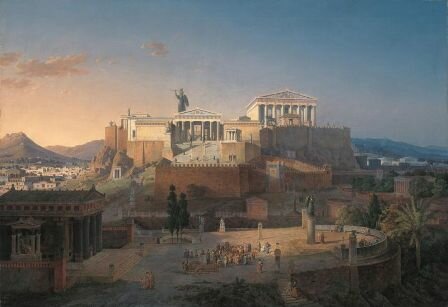One of these following facts about the Acropolis might make you want to visit this site. The Acropolis is an ancient citadel located on a hight rocky outcrop above the city of Athens and containing the remains of several ancient buildings of great architectural and historic significance, the most famous being the Parthenon. Although there are many other acropolis in Greece, the significance of the Acropolis of Athens is such that it is commonly known as “The Acropolis” without qualification. To get to know more about this site, here are some facts about the Acropolis you might be interested in.
Facts about the Acropolis 1: Neolithic Phase
The earliest instances of human occupation of the Acropolis belong to the Neolithic phase of the 4th millennium B.C., where evidences show human occupation in the caves around Attica.
Facts about the Acropolis 2: Megaron
The megaron was enclosed within a Cyclopean fortification wall, which denied the access of the hill to the enemies. It provided defense to the complex till about the 5th century B.C.
Facts about the Acropolis 3: Mycenaean Era
Remains of a deep well of Mycenaean era have also been recovered from underneath the hill. This well was seemingly the primary source of water supply to the complex, as well as a medium of protection from the enemies.
Facts about the Acropolis 4: Defense Purposes
Originally, the Acropolis was meant for defense purposes. The Greeks kept an eye on the positions of their enemies from the complex, at the time of war.
Facts about the Acropolis 5: Acropolis’ Hill
It served the purpose of both, a fortified citadel and a religious center, which houses one of the most famous buildings in the world, the Parthenon. This is why the hill of the Acropolis is called the ‘Sacred Rock of Athens’.
Facts about the Acropolis 6: Three Main Edifices
Three main structural edifices of the Acropolis are the Parthenon, the Erechteion and the Temple of Athena Nike. The Partheno is dedicated to the Goddess Athena. The Erechteion is said to be located on the most sacred corner of the Acropolis Hill, and was a place where all holy ceremonies linked to Goddess Athena and God Poseidon were held. The Temple of Athena Nike is a square structure with ionic architecture, located on the south-western edge of the hill.
Facts about the Acropolis 7: Temple of Athena Polias
The temple of Athena Polias was constructed on the Acropolis Hill around 570 – 550 B.C. This Doric style limestone shrine of the Protectress of the city was named as Hekatompedon, meaning ‘the one with hundred feet’, and probably stood right where the Parthenon stands today.
Facts about the Acropolis 8: The Theater of Dion
Apart from the three main structures, the Theater of Dionysus is a significant monument built at the foot of the Acropolis. It is an open-air theater, and probably the first of its kind in Athens.
Facts about the Acropolis 9: Cultural Significance
Every four years, the Athenians held a festival called the Panathenaea that rivaled the Olympic Games in popularity. During the festival, a procession (believed to be depicted on the Parthenon frieze) traveled through the city via the Panathenaic Way and culminated on the Acropolis.
Facts about the Acropolis 10: Restoration Project
A total of 2,675 tons of architectural members were restored, with 686 stones reassembled from fragments of the originals, 905 patched with new marble, and 186 parts made entirely of new marble. A total of 530 cubic meters of new Pentelic marble were used.
Hope you would find those Acropolis facts really interesting and useful for you additional reading.









